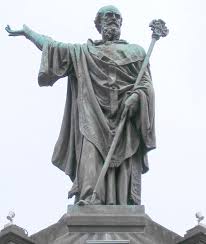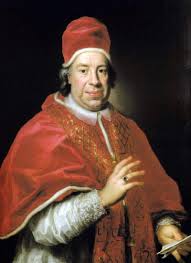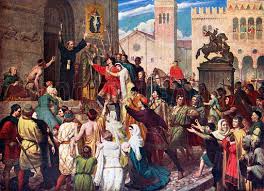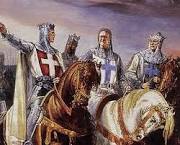 Pope Urban ll
Pope Urban ll 
In 1095, Alexius sent envoys to Pope Urban II asking for mercenary troops from the West to help confront the Turkish threat. Though relations between Christians in East and West had long been fractious, Alexius’ request came at a time when the situation was improving. In November 1095, at the Council of Clermont in southern France, the pope called on Western Christians to take up arms in order to aid the Byzantines and recapture the Holy Land from Muslim control. Pope Urban’s plea met with a tremendous response, both among lower levels of the military elite (who would form a new class of knights) as well as ordinary citizens; it was determined that those who joined the armed pilgrimage would wear a cross as a symbol of the Church.
Four armies of Crusaders were formed from troops of different Western European regions, led by Raymond of Saint-Gilles, Godfrey of Bouillon, Hugh of Vermandois and Bohemond of Taranto (with his nephew Tancred); they were set to depart for Byzantium in August 1096. A less organized band of knights and commoners known as the “People’s Crusade” set off before the others under the command of a popular preacher known as Peter the Hermit. Peter’s army traipsed through the Byzantine Empire, leaving destruction in their wake. Resisting Alexius’ advice to wait for the rest of the Crusaders, they crossed the Bosporus in early August. In the first major clash between the Crusaders and the Muslims, Turkish forces crushed the invading Europeans at Cibotus. Another group of Crusaders, led by the notorious Count Emicho, carried out a series of massacres of Jews in various towns in the Rhineland in 1096, drawing widespread outrage and causing a major crisis in Jewish-Christian relations.
When the four main armies of Crusaders arrived in Constantinople, Alexius insisted that their leaders swear an oath of loyalty to him and recognize his authority over any land regained from the Turks, as well as any other territory they might conquer; all but Bohemond resisted taking the oath. In May 1097, the Crusaders and their Byzantine allies attacked Nicea (now Iznik, Turkey), the Seljuk capital in Anatolia; the city surrendered in late June. Despite deteriorating relations between the Crusaders and Byzantine leaders, the combined force continued its march through Anatolia, capturing the great Syrian city of Antioch in June 1098. After various internal struggles over control of Antioch, the Crusaders began their march toward Jerusalem, then occupied by Egyptian Fatimids (who as Shi’ite Muslims were enemies of the Sunni Seljuks). Encamping before Jerusalem in June 1099, the Christians forced the besieged city’s governor to surrender by mid-July. Despite Tancred’s promise of protection, the Crusaders slaughtered hundreds of men, women and children in their victorious entrance into the city.
THE CRUSADER STATES AND THE SECOND CRUSADE (1147-49)
Having achieved their goal in an unexpectedly short period of time, many of the Crusaders departed for home. To govern the conquered territory, those who remained established four large western settlements, or Crusader states, in Jerusalem, Edessa, Antioch and Tripoli. Guarded by formidable castles, the Crusader states retained the upper hand in the region until around 1130, when Muslim forces began gaining ground in their own holy war (or jihad) against the Christians, whom they called “Franks.” In 1144, the Seljuk general Zangi, governor of Mosul, captured Edessa, leading to the loss of the northernmost Crusader state.
News of Edessa’s fall stunned Europe, and led Christian authorities in the West to call for another Crusade. Led by two great rulers, King Louis VII of France and King Conrad III of Germany, the Second Crusade began in 1147. That October, the Turks crushed Conrad’s forces at Dorylaeum, site of a great victory during the First Crusade. After Louis and Conrad managed to assemble their armies at Jerusalem, they decided to attack the Syrian stronghold of Damascus with an army of some 50,000 (the largest Crusader force yet). Previously well disposed towards the Franks, Damascus’ ruler was forced to call on Nur al-Din, Zangi’s successor in Mosul, for aid. The combined Muslim forces dealt a humiliating defeat to the Crusaders, decisively ending the Second Crusade; Nur al-Din would add Damascus to his expanding empire in 1154.
THE THIRD CRUSADE (1189-92)
After numerous attempts by the Crusaders of Jerusalem to capture Egypt, Nur al-Din’s forces (led by the general Shirkuh and his nephew, Saladin) seized Cairo in 1169 and forced the Crusader army to evacuate. Upon Shirkuh’s subsequent death, Saladin assumed control and began a campaign of conquests that accelerated after Nur al-Din’s death in 1174. In 1187, Saladin began a major campaign against the Crusader Kingdom of Jerusalem. His troops virtually destroyed the Christian army at the battle of Hattin, taking the city along with a large amount of territory.
Outrage over these defeats inspired the Third Crusade, led by rulers such as the aging Emperor Frederick Barbarossa (who was drowned at Anatolia before his entire army reached Syria), King Philip II of France and King Richard I of England (known as Richard the Lionheart). In September 1191, Richard’s forces defeated those of Saladin in the battle of Arsuf; it would be the only true battle of the Third Crusade. From the recaptured city of Jaffa, Richard reestablished Christian control over some of the region and approached Jerusalem, though he refused to lay siege to the city. In September 1192, Richard and Saladin signed a peace treaty that reestablished the Kingdom of Jerusalem (though without the city of Jerusalem) and ended the Third Crusade.

Though the powerful Pope Innocent III called for a new Crusade in 1198, power struggles in and between Europe and Byzantium drove the Crusaders to divert their mission in order to topple the reigning Byzantine emperor, Alexius III, in favor of his nephew, who became Alexius IV in mid-1203. The new emperor’s attempts to submit the Byzantine church to Rome met with stiff resistance, and Alexius IV was strangled after a palace coup in early 1204. In response, the Crusaders declared war on Constantinople, and the Fourth Crusade ended with the conquest and looting of the magnificent Byzantine capital later that year.
The remainder of the 13th century saw a variety of Crusades aimed not so much at toppling Muslim forces in the Holy Land as at combating any and all of those seen as enemies of the Christian faith. The Albigensian Crusade (1208-29) aimed to root out the heretical Cathari or Albigensian sect of Christianity in France, while the Baltic Crusades (1211-25) sought to subdue pagans in Transylvania. In the Fifth Crusade, put in motion by Pope Innocent III before his death in 1216, the Crusaders attacked Egypt from both land and sea, but were forced to surrender to Muslim defenders led by Saladin’s nephew, Al-Malik al-Kamil, in 1221. In 1229, in what became known as the Sixth Crusade, Emperor Frederick II achieved the peaceful transfer of Jerusalem to Crusader control through negotiation with al-Kamil. The peace treaty expired a decade later, and Muslims easily regained control of Jerusalem.
Through the end of the 13th century, groups of Crusaders sought to gain ground in the Holy Land through short-lived raids that proved little more than an annoyance to Muslim rulers in the region. The Seventh Crusade (1239-41), led by Thibault IV of Champagne, briefly recaptured Jerusalem, though it was lost again in 1244 to Khwarazmian forces enlisted by the sultan of Egypt. In 1249, King Louis IX of France led the Eighth Crusade against Egypt, which ended in defeat at Mansura (site of a similar defeat in the Fifth Crusade) the following year. As the Crusaders struggled, a new dynasty known as the Mamluks–descended from former slaves of the sultan–took power in Egypt. In 1260, Mamluk forces in Palestine managed to halt the advance of the Mongols, an invading force led by Genghis Khan and his descendants that had emerged as a potential ally for the Christians in the region. Under the ruthless Sultan Baybars, the Mamluks demolished Antioch in 1268, prompting Louis IX to set out on another Crusade, which ended in his death in North Africa (he was later canonized).
A new Mamluk sultan, Qalawan, had defeated the Mongols by the end of 1281 and turned his attention back to the Crusaders, capturing Tripoli in 1289. In what was considered the last Crusade, a fleet of warships from Venice and Aragon arrived to defend what remained of the Crusader states in 1290. The following year, Qalawan’s son and successor, al-Ashraf Khalil, marched with a huge army against the coastal port of Acre, the effective capital of the Crusaders in the region since the end of the Third Crusade. After only seven weeks under siege, Acre fell, effectively ending the Crusades in the Holy Land after nearly two centuries. Though the Church organized minor Crusades with limited goals after 1291–mainly military campaigns aimed at pushing Muslims from conquered territory or conquering pagan regions–support for such efforts disappeared in the 16th century, with the rise of the Reformation and the corresponding decline of papal authority.
The main point of this exhaustive historical overview is to focus on the devastating influence Christianity had on the (known) world during the years 900 thru 1400 AD (or as often now referred to as CE). These crusades were ill advised and driven by a Catholic hidden agenda. Not only did the crusaders set upon the Muslim and Jewish enclaves with a vengeance, they also laid to waste christian settlements as well – why, because in their ignorance they failed to recognize that wearing a turban did not constitute being a Muslim; that was merely the normal dress of the region.
By the 16th century the initial christian population of the region had been decimated by at least 50%. The region, once the pulse of agriculture and animal husbandry, was now a waste land, laying fallow. And finally, these results left in place a strong and bitter Muslim community/empire committed to waging future war on Europe.
The glorious stories of Richard the Lion Heart and other European marauders from the north are a figment of Hollywood. Christians and Christianity – but more so the Catholic Church, who should be ashamed of the atrocities they committed in the name of God.




 RSS Feed
RSS Feed